Imagine that washing clothes is a practice that has always existed, the interesting thing is to know what was used for this washing. Could it be that soap was already present in ancient times? If not, how was it done to wash clothes and household items?
The news is not very hygienic, instead of having that good smell of fabric softener, the clothes had an unpleasant odor of... urine, ah! That's right, but why exactly?
Soap in ancient times did not exist and when it appeared it was not cheap as it is today, the alternative was to use what was available to clean: urine was used with water to wash clothes. But don't think that this use had no scientific origin, urine has in its composition the chemical substance ammonia, based on this principle is that it was used with bleach in whitening the clothes.
Years later, soap began to be produced using animal fat (tallow) mixed with vegetable ashes. Already in the year 1400 soap was already produced in abundance in Spain, Italy and France.
By Líria Alves
Graduated in Chemistry
Do not stop now... There's more after the advertising ;)
See more!
Making soap: practical class
Would you like to reference this text in a school or academic work? Look:
SOUZA, Líria Alves de. "Soap or washing, which came first?"; Brazil School. Available in: https://brasilescola.uol.com.br/quimica/o-sabao-ou-pratica-lavar-roupa-qual-veio-primeiro.htm. Accessed on June 28, 2021.


